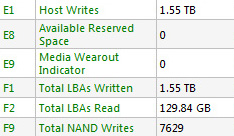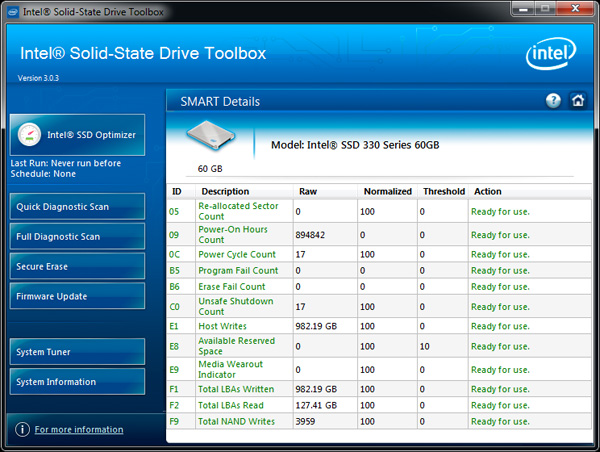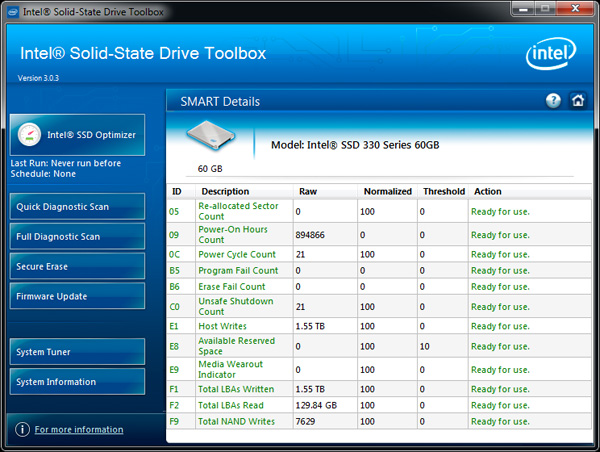The Intel SSD 330 Review (60GB, 120GB, 180GB)
by Anand Lal Shimpi on August 1, 2012 12:01 AM ESTLower Endurance: A Non-Issue
We've mentioned time and time again that NAND endurance is a non-issue for desktop (and even some enterprise) workloads.
Intel doesn't quantify the difference in endurance between the NAND used on the SSD 330 and the 520, it simply states that the 330's NAND will deliver a useful lifespan of 3 years and thus carries a 3 year warranty. Unfortunately, without access to the E2/E3/E4 counters we can't quickly figure out how long the 330 would last given a typical client workload. Thankfully Intel left one SMART wear indicator intact: the E9 attribute, otherwise known as the Media Wearout Indicator.
The normalized value of the E9 attribute (accessible via any SMART monitoring software, or Intel's SSD Toolbox) starts at 100 and decreases, linearly by integer increments, down to 0. Its meaning? The number of cycles the NAND media has undergone. At 100, your NAND is running at roughly full health. At 90, you've exhausted 10% of your NAND's lifespan. By the time the E9/MWI attribute gets down to 1 (99% of NAND p/e cycles have been used up) the counter stops decrementing and you're recommended to replace the drive. Even Intel admits however it's quite likely that at a value of 1 your drive will last for a considerable amount of time.
These are SandForce drives that implement real time data deduplication/compression so I wanted to create the worst case scenario to see how big of a deal this lower endurance NAND would be. I filled the 60GB Intel SSD 330 with incompressible data, leaving only its spare area untouched. I then ran a 4KB random write test, at a queue depth of 32, using incompressible data in four blocks of 6 hours, stopping only to look at the state of the E9/MWI attribute.
Even after 3959GB written to the 60GB drive, the media wear indicator remained at 100. If we do the math and assume that Intel isn't lying about the attribute decreasing linearly from 100 down to 0, it's possible the NAND on this particular 60GB SSD 330 is good for at least 6000 p/e cycles (3959GB/64GB = ~61 p/e cycles per NAND cell).
Not satisfied with these results I went in for another 24 hour round. By the end of it I had written 7629GB to the 60GB drive, at around 119 p/e cycles per NAND cell (assuming perfect wear leveling). The MWI hadn't budged:
Extrapolating based on this data you'd end up with over 10,000 p/e cycles for this particular drive. Whether or not this is accurate remains to be seen, but endurance is clearly not going to be an issue with Intel's SSD 330.
If you assume a typical client drive sees 10GB of writes per day, within a year you'd write 3650GB to the drive. I wrote that much in 24 hours. In fact, I wrote more than two years worth of data to the 60GB Intel SSD 330 in two days. All the while the Intel SSD 330 didn't even blink.
Note that as with any form of binning, you will see examples of drives that do better or worse than the one I've tested. Unless there's something horribly wrong with Intel's 25nm NAND process however, the difference is unlikely to be large enough where it'd be an issue.
As a side benefit to all of this experimenting with death is we can actually quantify write amplification on a SandForce drive.
Intel's 300i firmware, like all SandForce firmware, keeps track of NAND vs. host writes. Using that data I'm able to quantify write amplification during this fairly worst-case scenario workload:

7629GB of NAND writes vs. 1550GB of host writes = ~4.9x write amplification
SandForce maintains extremely low write amplification, even when faced with a hefty workload. Typical write amplification for client users will likely be far lower.












64 Comments
View All Comments
antef - Wednesday, August 1, 2012 - link
And, holy crap, Anand's chart is wrong, the m4 128 GB is now only $106 at Amazon. That's a steal!nextel2010 - Tuesday, October 2, 2012 - link
At this moment, Amazon has the Samsung 830 128GB at $89.99!! If I didn't already have a 128GB and 256GB already, I'm all over that one....owned66 - Wednesday, August 1, 2012 - link
i have 2 of these in raid 0HD tune bench it stays at 1000 MB/s then goes up and down then stays at 700 MB/s then goes back to 1000
im using a x77 motherboard
and also using the 6Gb/s port (not the marvell one)
Movieman420 - Wednesday, August 1, 2012 - link
I've been following the SSD endurance thread at XS for some time. There's one 64gb M4 that hit 0 MWI at 172TB of writes and is still chugging along at 1,.250+ TBs (that's 1.25 PB!!). Ofc not every drive is the same. There is a chart of the currently running endurance tests on the last page or 2 usually. To sum it up...nand endurance is not an issue as Anand stated.They have a Samsung 830 that just hit 3PBs!....it's mwi said the nand was worn out at 828TB writes...lmao
MrSpadge - Wednesday, August 1, 2012 - link
It's disappointing to see this drive switch to 9.5 mm when actually any SSD could be 7 mm standard. And Intel were the first to offer this (although with that stupid voided warrenty).MarsMSJ - Wednesday, August 1, 2012 - link
Anand should of touched on OSX and Intel's new drives even at the risk of sounding like a broken record. There some of us praying for the day Intel comes out with a new drive that works on OSX.Unfortunately, Samsung appears to be your best bet on OSX. I used a 320 series 160 GB drive and it just behaved poorly when I was using 150 GB of it. Not sure if it had anything to do with Repair Disk. Every other day OSX would recommend I run it because it believed my drive was corrupt. Sometimes it would even boot me right into Disk Utility. I ran Lion and Windows 7 in VMware fusion.
Strangely enough, the 320 behaved like these 330s in their "run into a corner" scenario.
kaelynthedove78 - Wednesday, August 1, 2012 - link
I noticed that you tested with a highly non-standard configuration, with EIST disabled.Has the Sandforce bug that causes the performance to plummet if EIST is enabled been fixed?
Nobody in their right mind would run a home desktop/laptop with EIST disabled..
jwcalla - Wednesday, August 1, 2012 - link
Hmmm... this is interesting. Where can I find more info about this? I haven't noticed such behavior yet but maybe I haven't been looking hard enough.Kristian Vättö - Thursday, August 2, 2012 - link
It's been fixed from what I know, or at least Anand told me to just leave those enabled (my setup is running normal settings as you can see in some of our recent SSD reviews). Anand has probably just left those settings to be what they were before.mattlach - Wednesday, August 1, 2012 - link
I presume the Vertex 4 is not in the comparison table due to its poor read speed when reviewed by Anandtech?Anandtech still needs to revisit the Vertex 4. The two firmware releases since launch have completely transformed the drive, and I wouldn't be surprised to see it near the top.